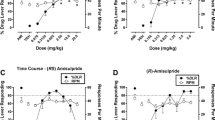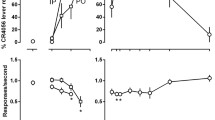Abstract
CL 284,846,N-[3-(3-cyanopyrazolo[1, 5-a]pyrimidin-7-yl)phenyl)]-N-ethylacetamide, is a novel non-benzodiazepine sedative-hypnotic with benzodiazepine-like sedative effects, but with less apparent liability for accompanying undesired side effects. In an effort to further characterize its pharmacological activity, CL 284,846 (3.0 mg/kg, IP, 30 min pretreatment) was established as a discriminative stimulus (DS) in rats (n=7). CL 284,846 (0.3–10.0 mg/kg) showed a dose-related increase in drug-appropriate responding up to the training dose and a dose-related decrease in response rate. The benzodiazepine agonist triazolam (0.1–1.0 mg/kg), the benzodiazepine partial agonist Ro 17-1812 (0.3–3.0 mg/kg) and the triazolopyridazine CL 218,872 (1.0–3.0 mg/kg) substituted for CL 284,846 in all rats, whereas the imidazopyridines zolpidem (3.0–10.0 mg/kg) and alpidem (10.0–30.0 mg/kg), the benzodiazepine partial agonist bretazenil (0.03–10.0 mg/kg) and the novel putative anxiolytic CL 273,547 (10.0–56.0 mg/kg) substituted in most, but not all, rats. Ro 17-1812, bretazenil, and CL 218,872 had no effect on response rate while the other drugs showed a concomitant decrease in rate. The 5-HT1A agonist buspirone (1.0–10.0 mg/kg) and the barbiturate pentobarbital (3.0–17.0 mg/kg) failed to substitute for CL 284,846 up to rate-decreasing doses. The benzodiazepine antagonist flumazenil (3.0–10.0 mg/kg) blocked the DS effects of CL 284,846 in most rats with no effect on response rate. Taken together, these results suggest that the DS effects of CL 284,846 are mediated via benzodiazepine receptors; however, the DS profile of CL 284,846 remains distinct from both benzodiazepine and non-benzodiazepine sedative-hypnotic drugs.
Similar content being viewed by others
References
Ator NA, Griffiths RR (1983) Lorazepam and pentobarbital drug discrimination in baboons: cross-drug generalization tests and interaction with Ro 15-1788. J Pharmacol Exp Ther 226:776–782
Ator NA, Griffiths RR (1986) Discriminative stimulus effects of atypical anxiolytics in baboons and rats. J Pharmacol Exp Ther 237:393–403
Ator NA, Griffiths RR (1989) Differential generalization to pentobarbital in rats trained to discriminate lorazepam, chlordiazepoxide, diazepam, or triazolam. Psychopharmacology 98:20–30
Barrett JE, Gleeson S (1991) Anxiolytic effects of 5-HT1A agonists, 5-HT3 antagonists and benzodiazepines: conflict and drug discrimination studies. In: Rodgers RJ, Cooper SJ (eds) 5-HT1A agonists, 5-HT3 antagonists and benzodiazepines: their comparative behavioral pharmacology. Wiley, Chichester, pp 133–157
Benavides J, Peny B, Ruano D, Vitorica J, Scatton B (1993) Comparative autoradiographic distribution of central ω (benzodiazepine) modulatory site subtypes with high, intermediate and low affinity for zolpidem and alpidem. Brain Res 604:240–250
Braestrup C, Nielsen M (1980) Multiple benzodiazepine receptors. Trends Neurosci 3:301–303
Colpaert FC, Desmedt LKC, Janssen PAJ (1976) Discriminative stimulus properties of benzodiazepines, barbiturates and pharmacologically related drugs; relation to some intrinsic and anticonvulsant effects. Eur J Pharmacol 37:113–123
Day IP, Clody DE, Monaghan MM, Abel MS, Dusza JP, Beer B (1992) Pharmacology of CL 284,846, a non-benzodiazepine sedative with reduced amnestic liability (303.4) Soc Neurosci Abstr 18:725
Facklam M, Schoch P, Bonetti EP, Jenck F, Martin JR, Moreau J-L, Haefely WE (1992) Relationship between benzodiazepine receptor occupancy and functional effects in vivo of four ligands of differing intrinsic efficacies. J Pharmacol Exp Ther 261:1113–1121
Haefely W (1984) Pharmacological profile of two benzodiazepine partial agonists: RO 16-6028 and RO 17-1812. Clin Neuropharmacol 7 [suppl 1]: 670–671
Haefely W (1990) Novel anxiolytics that act as partial agonists at benzodiazepine receptors. Trends Pharmacol Sci 11:452–456
Klepner CA, Lippa AS, Benson DI, Sano MC, Beer B (1979) Resolution of two biochemically and pharmacologically distinct benzodiazepine receptors. Pharmacol Biochem Behav 11:457–462
Knoflach F, Drescher U, Scheurer L, Malherbe P, Mohler H (1993) Full and partial agonism displayed by benzodiazepine receptor ligands at recombinant γ -aminobutyric acidA receptor subtypes. J Pharmacol Exp Ther 266:385–391
Langer SZ, Arbilla S (1988) Imidazopyridines as a tool for the characterization of benzodiazepine receptors: a proposal for a pharmacological classification as omega receptor subtypes. Pharmacol Biochem Behav 29:763–766
Langer SZ, Arbilla S, Tan S, Lloyd KG, George P, Allen J, Wick AE (1990) Selectivity for omega-receptor subtypes as a strategy for the development of anxiolytic drugs. Pharmacopsychiatry 23:103–107
Lippa AS, Coupet J, Greenblatt EN, Klepner CA, Beer B (1979) A synthetic non-benzodiazepine ligand for benzodiazepine receptors: a probe for investigating neuronal substrates of anxiety. Pharmacol Biochem Behav 11:99–106
Rijnders HJ, Jarbe TUC, Slangen JL (1991) The pentylenetetrazolecue antagonist actions of bretazenil (Ro 16-6028) as compared with midazolam. Pharmacol Biochem Behav 39:129–132
Sanger DJ (1987) Further investigation of the stimulus properties of chlordiazepoxide and zolpidem. Agonism and antagonism by two novel benzodiazepines. Psychopharmacology 93:365–368
Sanger DJ, Benavides J (1993) Discriminative stimulus effects of ω (BZ) receptor ligands: correlation with in vivo inhibition of [3H]-flumazenil binding in different regions of the rat central nervous system. Psychopharmacology 111:315–322
Sanger DJ, Zivkovic B (1986) The discriminative stimulus properties of zolpidem, a novel imidazopyridine hypnotic. Psychopharmacology 89:317–322
Sanger DJ, Perrault G, Morel E, Joly D, Zivkovic B (1987) The behavioral profile of zolpidem, a novel hypnotic drug of imidazopyridine structure. Physiol Behav 41:235–240
Wafford KA, Whiting PJ, Kemp JA (1993) Differences in affinity and efficacy of benzodiazepine receptor ligands at recombinant γ -aminobutyric acidA receptor subtypes. Mol Pharmacol 43:240–244
Wettstein JG, Gauthier B (1992) Discriminative stimulus effects of alprazolam and diazepam: generalization to benzodiazepines, antidepressants and buspirone. Behav Pharmacol 3:229–237
Young R, Glennon RA (1987) Stimulus properties of benzodiazepines: correlations with binding affinities, therapeutic potency, and structure activity relationships (SAR). Psychopharmacology 93:529–533
Young R, Urbancic A, Emrey TA, Hall P, Metcalf G (1987) Behavioral effects of several new anxiolytics and putative anxiolytics. Eur J Pharmacol 143:361–371
Zivkovic B, Morel E, Joly D, Perrault G, Sanger DJ, Lloyd KG (1990) Pharmacological and behavioral profile of alpidem as an anxiolytic. Pharmacopsychiatry 23:108–113
Author information
Authors and Affiliations
Rights and permissions
About this article
Cite this article
Vanover, K.E., Barrett, J.E. Evaluation of the discriminative stimulus effects of the novel sedative-hypnotic CL 284,846. Psychopharmacology 115, 289–296 (1994). https://doi.org/10.1007/BF02245068
Received:
Revised:
Issue Date:
DOI: https://doi.org/10.1007/BF02245068




